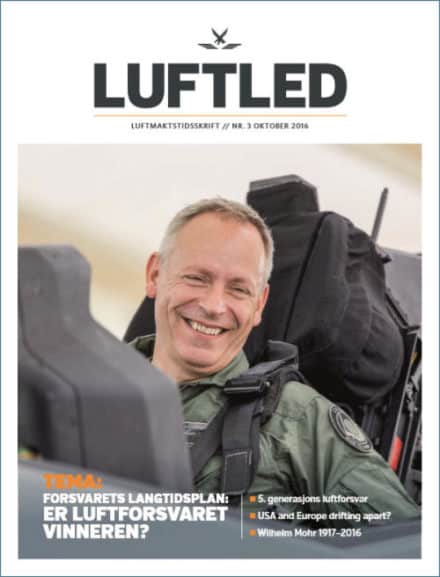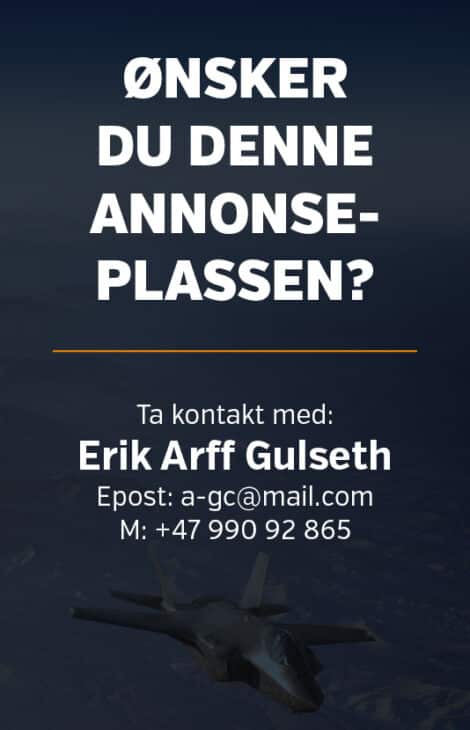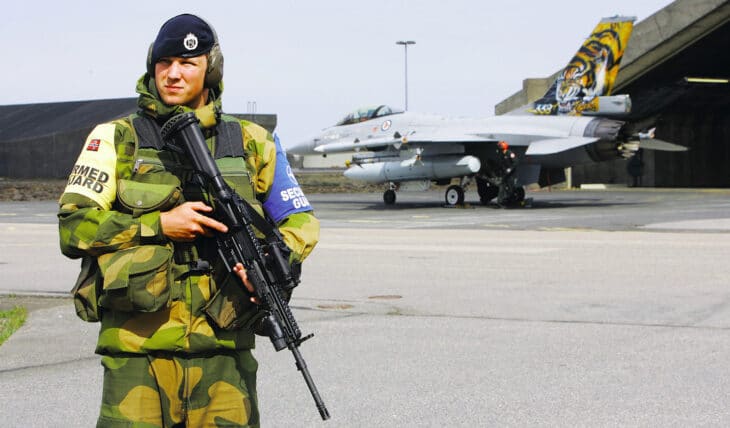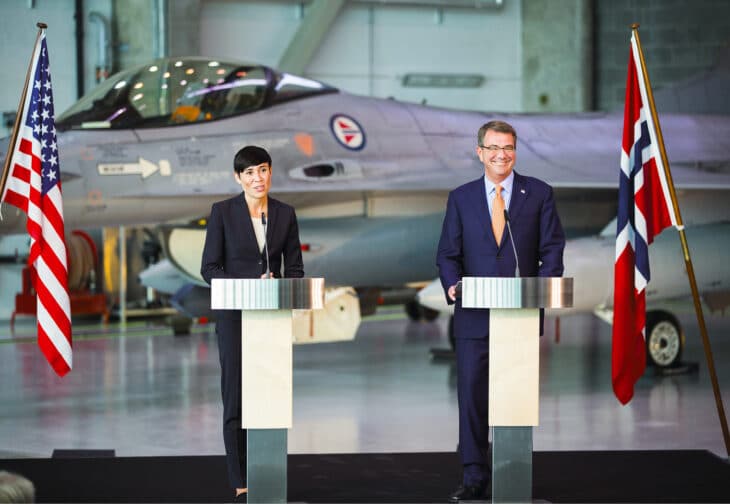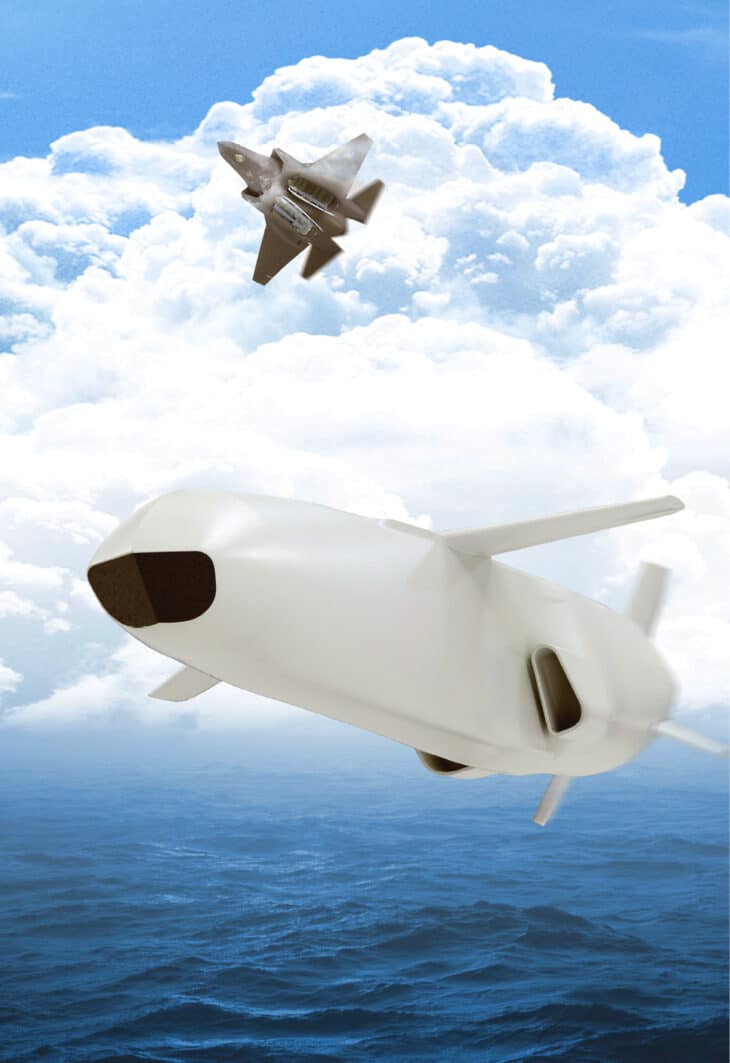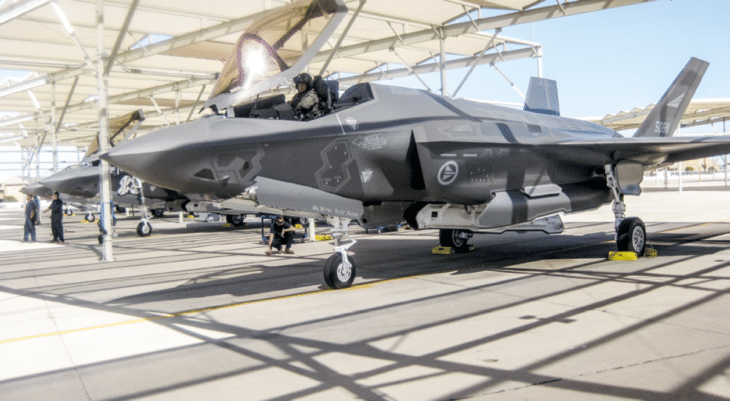European Security and the significance of the F-35
The introduction of F-35 fighters in European air forces marks a momentous transition from 4th generation fighters to the 5th generation. But the F-35 means much more than the mere replacement of one fighter by another one.
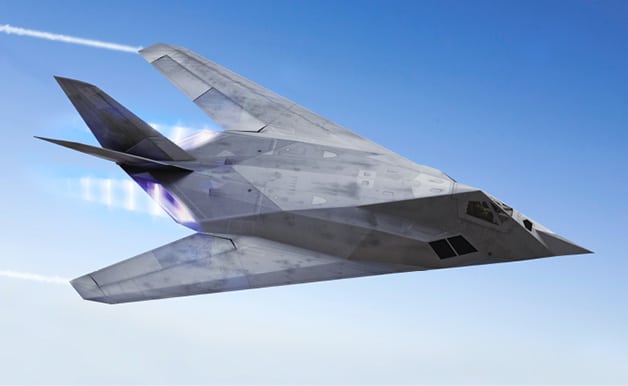
The real significance of the F35 is strategic and polical in nature, and must be assessed from a European security perspective. And that perspective is worrisome.
Addicted to the Air Power Advantage
The west has become addicted to its air power dominance. Since Operation Desert Storm in 1991 the military and political utility of air power has vastly increased. Indeed, a revolution in military affairs took place which was largely based on the rapid evolution in air power capabilities. Stealth fighters and bombers, persistent ISR, the proliferation of precision guided munitions, SEAD and EW capability, networking of sensors, shooters and C2 nodes, all combined to make the offence superior to defence in air warfare. The resulting persistent air superiority offered a virtual sanctuary that could be exploited for various purposes, such as Reconnaissance, Surveillance, Interdiction, CAS and Strategic Attacks. Air strikes became unprecedentedly accurate. With PGMs, one fighter could attack several targets in one mission, including dug-in tanks and artillery and intense air attacks could now obliterate entire armored columns. The result was a drastically shortening of the time required and the risk involved for ground units to complete the coalition victory, as Operation Iraqi Freedom once again demonstrated. Conventional strategic attack too was rediscovered. Precision munitions, stand-off and stealth capabilities offered new possibilities for strategic attacks against multiple target-categories of a nation state (military units, leadership, and critical infrastructure). Even if targets were in the vicinity of civilian objects, it was now possible to attack these near simultaneously in order to rapidly degrade the functioning of the entire ‘enemy system’ from the first moment of a campaign and cripple the strategic command capabilities before attacking fielded forces. Finally, Desert Storm suggested that military operations need not necessarily entail massive civilian casualties and the measure of ‘collateral damage’ to civilian infrastructure seemed to be controllable1.
The west has become addicted to its air power dominance. Since Operation Desert Storm in 1991 the military and political utility of air power has vastly increased
Cheaply without risks
In the arena of irregular warfare air power too has made huge strides in effectiveness due to persistent and wide area ISR, highly precise CAS and interdiction with unprecedented short response times and improved air-land integration. In stabilization and COIN missions this provides forces protection, allows SOF teams to cover wider areas than before with lower risk, and can assist so-called proxy-forces. This ‘Afghan Model’ has proven its worth in Afghanistan (2001-2014), Northern Iraq (2003), Libya (2011) and Mali (2013) and currently against ISIS2. Air power is also one of the few assets available that can target terrorist groups and guerrilla fighters in remote regions, and do so relatively effectively and cheaply without risks associated with the employment of large numbers of ground troops3.
Enhanced effectiveness and decreased risks translated into greater political utility to the extent that air power has become the ‘go-to’ military instrument for many international crises. Thus immediately following Desert Storm, offensive air power was employed to enforce No Fly Zones in the context of peace operations in the Balkan and northern Iraq and subsequently also in southern Iraq. During second halve of the 1990s western air power was twice pivotal as the key military instrument of Western coercive diplomacy against Serbia (Operation Deliberate Force and Operation Allied Force). In 2003 the US-led coalition used its air dominance so effectively against Iraqi ground forces that the ground offensive proceeded virtually unopposed and with unprecedented speed to Baghdad to topple Saddam Hussain. In 2011 Nato air power was employed in Libya in support of the UN doctrine of Responsibility to Protect, which amounted to a campaign of coercive diplomacy. Indeed, precision age air power suits the western sensibility concerning collateral damage and has become the defining and indeed normative feature of the western way of warfare.
The air power gap: the paradox
There is a remarkable paradox though. While Europe’s security concern from 1990 till 2014 have put an emphasis on expeditionary and power projection capabilities – which are precisely some of the key attributes of air power – Europe disinvested in air power. It has underappreciated the extent to which the new western way of war with its emphasis on risks mitigation, casualty sensitivity, and force protection depends on a continuous umbrella of sophisticated air power assets that provide rapid precision intelligence and if necessary kinetic response capabilities. Europe’s oft discussed capability gap is largely an air power gap – as became evident during operation Allied Force: US forces catered for 60% of all sorties, dropped 80% of all expended ordnance, provided 70% of all support sorties and 90% of all SEAD and EW missions, not to mention the fact that without US support NATO would have lacked effective command facilities4. Europe was fatally and unacceptably dependent on US ‘enablers’ and ‘precision shooter’. Already in 1997 senior defence analists warned Europe to ‘mind the gap’ as Europe was losing its ability to operate alongside US forces5.
In response, since 1999 NATO has launched several initiatives, starting with the Defence Capabilities Initiative (DCI), which identifiedsix areas of high priority were identified, involving strategic lift, air-to-air-refuelling, Suppression of Enemy Air Defences, Support Jamming, Precision Guided Munitions and Secure Communications6. Over the past decade by and large those shortfalls have persisted7. Budgetary constraints were one culprit of Europe military deficit8, but the heart of the problem is policy re-orientation and force restructuring. Most European armed forces have retained their orientation on static man-power intensive territorial defense. By 2005 Europe still had 1.5 million people in arms, and in excess of 10.000 tanks. But only 10 to 15 % of those troops were actually deployable9. Nato thus embarked on a ‘Transformation’ initiative which stood for accallerated innovation, catching up on the RMA, adopting the Network Centric Warfare concept, improving expeditionary capabilities, and closing the capability gap, in short, adopting the New American Way of War 10. However, complacency11, vested service interests, inter-service rivalry, different perspectives within political and military elites on the necessity to really transform their militaries in light of the absence of real security threats, and other societal priorities – the financial and economic crises – all contributed to the disappointing pace of military innovation in Europe12.
Thus, European air forces continued their decline, reducing the number of bases and command facilities and disbanding Nato’s once formidable GBAD air defence capabilities.
Very few air forces invested in long range stand-off strike, SEAD or EW capabilities. AAR and ISR capabilities grew only very slowly if at all. By 2011 combat capable fighter strenght was about 1200, down from 3000 two decades earlier, with numbers continuing to fall rapidly annually. This implied that air campaign intensity and sustainability would suffer dramatically, keeping in mind that a small scale air campaign such as Allied Force eventually required about 1000 combat aircraft. Importantly too, two decades after stealth had demonstrated its huge operational and strategic relevance, no European military had a stealthy 5th Generation in its inventory.
While Europe’s security concern from 1990 till 2014 have put an emphasis on expeditionary and power projection capabilities – which are precisely some of the key attributes of air power – Europe disinvested in air power
Addicted to US support
The over-reliance on US so-called ‘enablers’ (long range strike, EW, SEAD, ISR, C2) became increasingly problemic for the alliance. Operation Unified Protector, the intervention in Libya in 2011, once again demonstrated, the severity of the air power gap13.
In a repeat of Allied force, without US support Unified Protector was probably impossible despite the fact that OUP was a very limited operation with only 55-150 daily sorties (it never achieved the 350 daily sortie rate aimed for). Sustainability too was becoming a distinct issue: a number of European coalition partners had to withdraw their commitment during the operation due to maintenance requirements. Others suffered shortage of precision munitions quite early into the operation, suggesting that stockpiles were dramatically low. Several analysts thus concluded that without US support, European militaries can most likely perform only one moderate-sized operation at a time and will be hard-pressed to meet the rotation requirements of a protracted, small-scale irregular warfare mission14. And US support has become in doubt. In June 2011 US defence secretary Gates predicted a Nato consigned to “military irrelevance” in a “dim if not dismal” future unless allies stepped up to the plate […]. US political leaders [….] may not consider the return on America’s investment in Nato worth the cost15. Moreover, the so-called pivot to Asia implied a significant shift of United States foreign and defence policy from Europe and the Middle East to the east and South-East of Asia16. This means that it can no longer be assumed that under any circumstance that the United States will be willing to make substantial contributions in terms of capabilities and competencies to Europe. Therefore, as one official study noted, Europe must take into account that it has to be capable of independently securing its interests at the periphery of NATO’s geographical Area of Operational Responsibility. With the current shortfalls, NATO has a challenge in meeting its Level of Ambition. Given the trends the gap between capability and ambition will only become worse17. This was published in March 2014.
A Revisionist Russia
With the Spring 2014 annexation of the Crimea, the emergence of a revisionist Russia has transformed the air power gap from primarily an operational handicap during expeditionary interventions, as well as a political embarrassment, into a security problem. Russia has become an unpredictable power, according to Francois Heisbourg, and indeed Russia displays increasingly an anti-western political narrative which is fuelled by nationalism, honor, and a historic perception of identity and humiliation by the West. It manifests an enmity towards international law, western institutions and values. It seemingly wants to regain the Cold War era spheres of influence between Russia and Western Europe18. Its military doctrine and capabilities seem geared to support this political aim. In waging persistent shadow wars using cyber-operations, the deployment of special forces dressed as civilians and ‘little green men’, disinformation campaigns and denying involvement, it deliberately tries to remain below the threshold of Nato Article 5.
This Hybrid Warfare19, however, may not be the real or only problem now facing Western Europe20. What the Crimea crisis demonstrated really was the rapid modernization of Russian conventional forces. It demonstrated the ability to conduct intimidating snap exercises – some involving up to 150,000 military personnel – along the borders of Eastern European countries involving large army and air formations. Part and parcel of this new strategy is the threat of nuclear weapons. The combination of these capabilities translates into options to rapidly create facts on the ground forcing Nato and the EU to develop quick responses. Russia could then influence that response by threatening with nuclear escalation21. While this does not necessarily mean Russia is prepared for a direct confrontation with NATO, Russian prime minister Medvedev did not reassure Western leaders when he stated that there is the risk of a 3rd world war and the emergence of a new cold war22.
The 2016 Nato Warsaw Summit communiqué recognizes that Russia’s ‘aggressive actions, provocative military activities and its demonstrated willingness to attain political goals by the threat and use of force are a source of regional instability and fundamentally challenge the Alliance’23. Subsequently, since 2014 a flurry of initiatives was taken to demonstrate resolve and unity, avoid the perception of weakness that Russia could exploit, and to re-assure Baltic, Central European and Scandinavian countries. A renewed emphasis has been placed on deterrence and collective defence24. The Very High Readiness Joint Task Force (VJTF) was lanched, small headquarters would be established and the NRF was to be expanded. Small military capabilities would be prepositioned in the east, air policing would be intensified and the number of exercises enhanced. In Estonia, Latvia, Lithuania and Poland multinational battalion sized battlegoups would be established to ‘unambiguously demonstrate, as part of our overall posture, Allies’ solidarity, determination, and ability to act by triggering an immediate Allied response to any aggression’25.
The A2AD challenge: losing the certainty of air superiority
However, Russia’s military modernization is particularly geared towards negating Nato’s asymmetric advantage in the air power arena, undermining Nato’s conventional deterrence capabilities. Russia has invested heavily in Anti Acces and Area Denial (A2AD) capabilities: electronic warfare systems, cyber warfare capabilities, and long range Surface to Surface Missiles and Surface to Air systems. As a result, today, the West needs to reconsider how to preserve Western supremacy in the commons (sea, air, space and cyber-space) and how to use the commons to project power in a contested environment. As Air Force (USAF) General Frank Gorenc, then commander of U.S. Air Forces in Europe and Africa stated, ‘The advantage that we had from the air, I can honestly say, is shrinking […] Those A2/AD capabilities are fundamentally undermining the essence of the American way of war26.
This problem is particularly accute along the borders of the Europe and in its heart; Kaliningrad27. With its amassed air defence and surface to surface missile capabilities it can deny air operations over large parts of the Balkan and Poland, it can threaten military facilities and transport infrastructure – and thus reinforcement (such as the VJTF) – in eastern Europe and well into Germany and deny the use of sea lines of communications. US capabilities in Europe are not sufficient to tackle this A2AD problem. Russia is increasingly able to create positions of local military advantage in its immediate vicinity, advantages that extend to the ability to seize and hold territory, and then to be able to deploy higher order capabilities, ranging from anti-access/area-denial systems to nuclear weapons, to block, deter, negate or frighten NATO in its attempts to push these forces back28. A RAND study concluded that ‘As currently postured, NATO cannot successfully defend the territory of its most exposed members’29.
The meaning of the F-35: restoring conventional deterrence
Nato’s array of initiatives since 2014 amount to re-discovering the lost art of conventional and nuclear deterrence, territorial defence and conventional warfare. Air power plays a large role in this. To wit, 9 out of 16 Nato capability priority shortfall areas relate to air power. In no small measure the conventional deterrence problem equates with ensuring deterrence credibility by addressing the persistent capability gap in which Air C2, airborne electronic attack, air to air refuelling assets, long range precision strike systems, SEAD, ISR, air superiority, and TBMD feature prominently. While other joint assets too can help solve the air power problem (cyber weapons, SOF, aviation and ship-to-surface missiles can play a very useful role in suppressing SSM and SAM systems), without improving air defence and strike capabilities, Nato will be hard pressed to effectuate conventional deterrence. The certainty of the air sanctuary has disappeared. Against Russia’s SAM systems, Nato air defence and offensive counter air operations will once again become a slugging match. Russia’s SSMs form a direct threat to the concentrated few scarce Air C2 facilities and air bases. Joint campaign plans therefor once again need to consider carefully allocation of assets and phasing; parallel warfare a la Desert Storm and Iraqi Freedom is likely infeasible. Information dominance will not happen as reconnaissance and surveillance missions may well be impossible. Finding and killing SAM systems and the related C2 facilities may subsequently take a very long time. During this phaze Interdiction and CAS missions with current PGMs such as the JDAM will produce high attrition rates until long range stand-off munitions can ‘out-range’ the Russian SAMS systems. Campaign intensity, persistence and sustainability will become a pressing concern as will munition stockpiles, the scarcity of military airfields with hardened facilities, the lack of GBAD, and the lack of redundancy in Air C2 facilities30.
While the introduction of the F-35 certainly does not solve all issues, it ensures interoperability with the US military, it limits the operational dependency on US support assets in air campaigns and its inherent stealth, EW, SEAD and ISR features address a significant capability gap that threatens to paralyze future European air operations. It will become a critical asset in Europe’s air defence and strike capabilities as non-stealth platforms have a very limited chance of survival in the face of Russia’s A2AD threat. The F-35 will probably also be called upon as SEAD and sweep escort for 4th Generation fighters which will continue to form the backbone of many European operations. But quantity is a quality. It will be a long time before Europe can boast a substantial number of operational F-35 squadrons and even when these are all-in theater, the number of F-35s will probably never exceed 500. The F-35 will thus become a critical ‘high demand-low density’ asset that assures that Nato can conduct long range precision strike missions, as well as DCA and OCA missions in a contested environment. All this implies that the F-35 will become a crucial foundation for Nato’s conventional deterrence and war fighting capability in the new A2AD era. And with the proliferation of modern SAM systems (as well as 5th Generation Chinese and Russian fighter aircraft) to many other states, the introduction of the F-35 is a first necessary step to ensure European air forces remain capable to conduct interventions effectively and with modest risk levels that Europe’s politicians and publics have become accustomed to. That is the real significance of the introduction of the F-35.
About the Author:
Air Commodore Dr. Frans Osinga is Professor in War Studies, Head of the Military Operational Art and Science Section, and Chair of the War Studies Program, one of the three BA-level programs taught at the Faculty of Military Studies of the Netherlands Defence Academy in Breda. He holds a PhD in political science from Leiden University.
